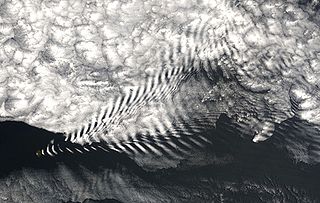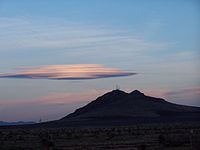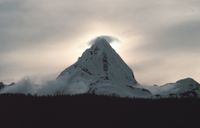Difference between revisions of "AY Honors/Weather/Answer Key"
m (89 revision(s) from w:Orographic lift) |
|||
| (5 intermediate revisions by the same user not shown) | |||
| Line 1: | Line 1: | ||
[[Image:Wave cloud.jpg|thumb|320 px|This wave cloud pattern formed off of the [[Île Amsterdam]] in the far southern [[Indian Ocean]], due to orographic lift of an airmass by the island, producing alternating bands of condensed and invisible humidity downwind of the island as the moist air moves in vertical waves and the moisture successively condenses and evaporates.]] | [[Image:Wave cloud.jpg|thumb|320 px|This wave cloud pattern formed off of the [[Île Amsterdam]] in the far southern [[Indian Ocean]], due to orographic lift of an airmass by the island, producing alternating bands of condensed and invisible humidity downwind of the island as the moist air moves in vertical waves and the moisture successively condenses and evaporates.]] | ||
| − | '''Orographic | + | '''Orographic lift''' occurs when an [[air mass]] is forced from a low [[elevation]] to a higher elevation as it moves over rising terrain. As the air mass gains [[altitude]] it expands and cools [[Adiabatic cooling|adiabatically]]. This cooler air cannot hold the moisture as well as warm air and this effectively raises the [[relative humidity]] to 100%, creating [[cloud]]s and frequently [[precipitation (meteorology)|precipitation]]. |
==Effects of orographic lifting== | ==Effects of orographic lifting== | ||
| Line 6: | Line 6: | ||
Precipitation induced by orographic lift occurs in [[Rain shadow#Regions of notable rain shadow|many places throughout the world]]. Examples include: | Precipitation induced by orographic lift occurs in [[Rain shadow#Regions of notable rain shadow|many places throughout the world]]. Examples include: | ||
* The eastern seaboard of Australia, which faces prevailing easterly winds, | * The eastern seaboard of Australia, which faces prevailing easterly winds, | ||
| − | * The mountains of [[New Zealand]], which faces a prevailing westerly flow | + | * The mountains of [[New Zealand]], which faces a prevailing westerly flow off the [[Tasman Sea]]. |
| − | * The southern [[Andes]], which faces a prevailing westerly flow | + | * The southern [[Andes]], which faces a prevailing westerly flow off the [[Pacific Ocean]]. |
* The [[Northwestern United States]] and [[Canada]] ([[Oregon]], [[Washington]] and [[British Columbia]]) see prevailing westerly flow off the northern [[Pacific Ocean]]. Places on the sea-facing side of coastal mountains see over 100 inches (over 2.5 m) of [[precipitation (meteorology)|precipitation]] per year. These locales are on the side of the [[mountain]]s which are in the path of [[storm]] systems, and therefore receive the moisture which is effectively squeezed from the clouds. | * The [[Northwestern United States]] and [[Canada]] ([[Oregon]], [[Washington]] and [[British Columbia]]) see prevailing westerly flow off the northern [[Pacific Ocean]]. Places on the sea-facing side of coastal mountains see over 100 inches (over 2.5 m) of [[precipitation (meteorology)|precipitation]] per year. These locales are on the side of the [[mountain]]s which are in the path of [[storm]] systems, and therefore receive the moisture which is effectively squeezed from the clouds. | ||
| Line 18: | Line 18: | ||
[[Image:Mountains from westlands.jpg|thumb|400px|right|A view of the Front Range of the Rockies capped by a föhn wall.]] | [[Image:Mountains from westlands.jpg|thumb|400px|right|A view of the Front Range of the Rockies capped by a föhn wall.]] | ||
:''Main article: [[Rain shadow]]'' | :''Main article: [[Rain shadow]]'' | ||
| − | The highest precipitation amounts are found slightly upwind from the prevailing winds at the crests of mountain ranges, where | + | The highest precipitation amounts are found slightly upwind from the prevailing winds at the crests of mountain ranges, where they relieve and therefore the upward lifting is greatest. As the air descends the lee side of the mountain, it warms and dries, creating a rain shadow. On the lee side of the mountains, sometimes as little as 15 miles (25 km) away from high precipitation zones, annual [[precipitation (meteorology)|precipitation]] can be as low as 8 inches (200 mm) per year.<ref name="Whiteman">{{cite book|author=Whiteman, C. David|title=Mountain Meteorology: Fundamentals and Applications |publisher=Oxford University Press|year=2000|id=ISBN 0-19-513271-8}}</ref> |
Areas where this effect is observed include: | Areas where this effect is observed include: | ||
| Line 27: | Line 27: | ||
* Canadian [[Prairies]] | * Canadian [[Prairies]] | ||
* The [[Hawaii|Hawaiian]] [[island]] of [[Kauai]]. | * The [[Hawaii|Hawaiian]] [[island]] of [[Kauai]]. | ||
| − | * [[California]]'s [[Central Valley]]. | + | * [[California]]'s [[Central Valley (California)|Central Valley]]. |
* The [[Great Basin]]. | * The [[Great Basin]]. | ||
| Line 36: | Line 36: | ||
* [[Wave cloud]]s are lenticular clouds, created when an [[air mass]] passes over a geographic feature and a standing wave forms downwind. | * [[Wave cloud]]s are lenticular clouds, created when an [[air mass]] passes over a geographic feature and a standing wave forms downwind. | ||
* A ''banner cloud'' is a cloud that forms downstream from the upper lee slopes of isolated, steep-sided mountains. This cloud is similar to the condensation observed off the tips of high-performance aircraft wings when they operate in humid conditions; it is created by the vortices and local uplifting in the air caused by the orographic lifting as the wind passes the mountain. The most famous such cloud forms routinely in the lee of the [[Matterhorn]].<ref name="Whiteman" /><ref>[http://www.atmos.washington.edu/gcg/Atlas/phot_oro03.html Example of a banner cloud forming in the lee of the Matterhorn.]</ref>. | * A ''banner cloud'' is a cloud that forms downstream from the upper lee slopes of isolated, steep-sided mountains. This cloud is similar to the condensation observed off the tips of high-performance aircraft wings when they operate in humid conditions; it is created by the vortices and local uplifting in the air caused by the orographic lifting as the wind passes the mountain. The most famous such cloud forms routinely in the lee of the [[Matterhorn]].<ref name="Whiteman" /><ref>[http://www.atmos.washington.edu/gcg/Atlas/phot_oro03.html Example of a banner cloud forming in the lee of the Matterhorn.]</ref>. | ||
| − | * A ''foehn wall'' is an extensive cloud formed along and parallel to the ridge line. The wall appears stationary, while the wind flows through; moisture condenses on the upslope and evaporating when it descends the lee slope. When viewed as one faces it, it often appears to have an abrupt wall like edge. The foehn wall is a common feature along the [[Front Range]] of the [[Colorado]] Rockies.<ref name="Whiteman" /> | + | * A ''foehn wall'' is an extensive cloud formed along and parallel to the ridge line. The wall appears stationary, while the wind flows through; moisture condenses on the upslope and evaporating when it descends the lee slope. When viewed as one faces it, it often appears to have an abrupt wall like edge. The foehn wall (or föhn wall) is a common feature along the [[Front Range]] of the [[Colorado]] Rockies.<ref name="Whiteman" /> |
* A ''[[Chinook wind#Chinook arch|chinook arch cloud]]'' forms above a mountain range, usually at the beginning of a chinook wind as a resulting of orographic lifting over the range. It appears when seen from downwind to form an arch over the mountain range. A layer of clear air separates it from the mountain.<ref name="Whiteman" /> | * A ''[[Chinook wind#Chinook arch|chinook arch cloud]]'' forms above a mountain range, usually at the beginning of a chinook wind as a resulting of orographic lifting over the range. It appears when seen from downwind to form an arch over the mountain range. A layer of clear air separates it from the mountain.<ref name="Whiteman" /> | ||
Revision as of 02:07, 15 May 2007

Orographic lift occurs when an air mass is forced from a low elevation to a higher elevation as it moves over rising terrain. As the air mass gains altitude it expands and cools adiabatically. This cooler air cannot hold the moisture as well as warm air and this effectively raises the relative humidity to 100%, creating clouds and frequently precipitation.
Effects of orographic lifting
Precipitation
Precipitation induced by orographic lift occurs in many places throughout the world. Examples include:
- The eastern seaboard of Australia, which faces prevailing easterly winds,
- The mountains of New Zealand, which faces a prevailing westerly flow off the Tasman Sea.
- The southern Andes, which faces a prevailing westerly flow off the Pacific Ocean.
- The Northwestern United States and Canada (Oregon, Washington and British Columbia) see prevailing westerly flow off the northern Pacific Ocean. Places on the sea-facing side of coastal mountains see over 100 inches (over 2.5 m) of precipitation per year. These locales are on the side of the mountains which are in the path of storm systems, and therefore receive the moisture which is effectively squeezed from the clouds.
Rain shadowing
- Main article: Rain shadow
The highest precipitation amounts are found slightly upwind from the prevailing winds at the crests of mountain ranges, where they relieve and therefore the upward lifting is greatest. As the air descends the lee side of the mountain, it warms and dries, creating a rain shadow. On the lee side of the mountains, sometimes as little as 15 miles (25 km) away from high precipitation zones, annual precipitation can be as low as 8 inches (200 mm) per year.&
Areas where this effect is observed include:
- The Atacama Desert in Peru and Chile.
- Switzerland's Rhone valley.
- Areas east of the Cascade range in the Pacific Northwest (Washington and Oregon).
- Areas east of the Olympic Mountains in Washington state.
- Canadian Prairies
- The Hawaiian island of Kauai.
- California's Central Valley.
- The Great Basin.
Atmospheric waves
As air flows over mountain barriers, orographic lift can create a variety of wave effects, which produce vertical air motion. If the air mass is close to the dew point, the waves may show as a variety of leeward clouds&:
- Lenticular clouds are stationary lens-shaped clouds that form at high altitudes, normally aligned at right-angles to the wind direction. Orographic lifting creates a wave which creates the condition for cloud formation.
- A cap cloud is a special form of the lenticular cloud with a base low enough that it forms around and covers the peak, capping it.&
- Wave clouds are lenticular clouds, created when an air mass passes over a geographic feature and a standing wave forms downwind.
- A banner cloud is a cloud that forms downstream from the upper lee slopes of isolated, steep-sided mountains. This cloud is similar to the condensation observed off the tips of high-performance aircraft wings when they operate in humid conditions; it is created by the vortices and local uplifting in the air caused by the orographic lifting as the wind passes the mountain. The most famous such cloud forms routinely in the lee of the Matterhorn.&&.
- A foehn wall is an extensive cloud formed along and parallel to the ridge line. The wall appears stationary, while the wind flows through; moisture condenses on the upslope and evaporating when it descends the lee slope. When viewed as one faces it, it often appears to have an abrupt wall like edge. The foehn wall (or föhn wall) is a common feature along the Front Range of the Colorado Rockies.&
- A chinook arch cloud forms above a mountain range, usually at the beginning of a chinook wind as a resulting of orographic lifting over the range. It appears when seen from downwind to form an arch over the mountain range. A layer of clear air separates it from the mountain.&
Leeward winds
Downslope winds occur on the leeward side of mountain barriers when a stable air mass is carried over the mountain by strong winds that increase in strength with height. Moisture is removed and latent heat released as the air mass is orographically lifted. As the air mass descends, it is compression heated. The warm Föhn wind, locally known as the Chinook wind, Bergwind or Diablo wind or "Nor-Wester" depending on the region, provide examples of this type of wind, and are driven in part by latent heat released by orographic lifting induced precipitation.
A similar class of winds, the Sirocco, the Bora and Santa Ana winds, are examples where orographic lifting has limited effect since there is limited moisture to remove in the Saharan or other air masses; the Sirocco, Bora and Santa Ana are driven primarily by compression heating.
References
es:Nube orográfica fr:Onde orographique it:Sollevamento orografico no:Orografisk heving nn:Orografisk heving fi:Orografinen pilvi





